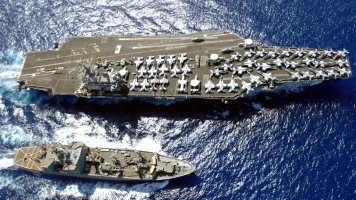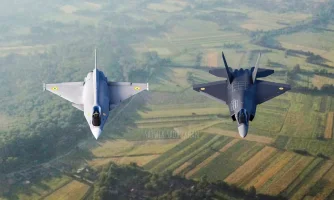- Views: 2K
- Replies: 36

The Indian Navy is considering a significant modernization effort focused on acquiring Landing Helicopter Docks (LHDs) optimized for operating Unmanned Aerial Vehicles (UAVs), also known as drones. This strategic move aims to enhance the Navy's capabilities in the crucial Indian Ocean Region (IOR) while maintaining cost-effectiveness.
LHDs are multi-role warships traditionally used for amphibious operations, capable of deploying troops, helicopters, and landing craft. However, the Navy's vision involves adapting these platforms, or procuring new ones, specifically designed to serve as mobile bases for a variety of drones. This reflects a growing global trend of integrating unmanned systems into naval warfare.
The adaptability of LHDs is a key advantage. They can be modified to support both traditional naval operations and emerging drone-based strategies. This allows the Navy to maintain a flexible force ready to respond to a wide range of situations, from conventional threats to new challenges.
One of the primary benefits of this approach is extended operational reach. With advancements in drone technology, including increased range and flight endurance, LHDs could launch UAVs for long-duration missions. These missions could include reconnaissance, surveillance, and even combat operations over extensive maritime and coastal areas, significantly bolstering India's strategic presence in the IOR.
From an economic perspective, operating drones from LHDs offers potential cost savings compared to traditional aircraft carriers for specific types of missions. Drones can remain deployed for extended periods without the need for human pilots, which lowers operational expenses and reduces the risks inherent in manned aircraft flights.
Furthermore, LHDs equipped with drones could provide constant aerial surveillance, a critical capability for monitoring shipping lanes, detecting submarine activity, and providing early warning of potential threats. In combat scenarios, drones could perform tasks such as electronic warfare and precision strikes, all managed from the relative safety of the LHD. These drones could potentially operate in coordination with other naval vessels for integrated operations.
Beyond military applications, these specialized ships could play a crucial role in humanitarian aid and disaster relief. Drones could be used to rapidly assess damage, deliver essential supplies, or provide communication links in areas where traditional methods are difficult or impossible.
The Indian Navy's plan also anticipates future technological developments. LHDs can be adapted to accommodate evolving drone designs, including Vertical Take-Off and Landing (VTOL) UAVs, loitering munitions (drones designed to wait in an area before striking a target), and even Unmanned Combat Aerial Vehicles (UCAVs) for air-to-air combat.
Future possibilities even include launching coordinated swarms of drones, potentially leveraging artificial intelligence for autonomous operations.
The LHD program could function as a practical testing ground for innovative naval aviation concepts. It would enable the Navy to experiment with various drone configurations and operational strategies.
The Indian Navy's interest in LHDs optimized for UAV operations mirrors a global trend. Unmanned systems are increasingly becoming a core component of modern naval warfare. By investing in this area, India aims not only to strengthen its naval capabilities but also to establish itself as a leader in maritime drone operations.
Given the strategic importance of the Indian Ocean and India's need to maintain a strong naval presence, LHDs equipped with UAVs are viewed as a crucial asset for both defense and projecting power.


